Danube River Cruises as a Strategy for Representing Historical Heritage and Developing Cultural Tourism in Serbia
Abstract
1. Introduction
1.1. Theoretical Framework for River Cruise Tourism
1.2. Methodological Framework and Technical Research Details
1.3. The Study Area
2. Persistence in the Creation of Tourist Products
3. Expansion of Danube River Cruises Until 2020
4. Implementation of Strategy through Spatial and Detailed Urban Plans
5. Heritage Locations as a Factor for Locating New Port Locations along the Danube
6. Discussions
7. Conclusions
Author Contributions
Funding
Conflicts of Interest
References
- Tomej, K.; Lund-Durlacher, D. Research note: River cruise characteristics from a destination management perspective. J. Outdoor Recreat. Tour. 2020, 30. [Google Scholar] [CrossRef]
- Erfurt-Cooper, P. European waterways as a source of leisure and recreation. In River Tourism; Prideaux, B., Cooper, M., Eds.; CABI: Wallingford, UK, 2009; pp. 95–117. ISBN 978-1-845-93468-2. [Google Scholar]
- Van Balen, M.; Dooms, M.; Haezendonck, E. River tourism development: The case of the port of Brussels. Res. Transp. Bus. Manag. 2014, 13, 71–79. [Google Scholar] [CrossRef]
- Dwyer, L.; Forsyth, P. Economic impacts of cruise tourism in Australia. J. Tour. Stud. 1996, 7, 36–45. [Google Scholar]
- Dwyer, L.; Forsyth, P. Economic significance of cruise tourism. Ann. Tour. Res. 1998, 25, 393–415. [Google Scholar] [CrossRef]
- McCarthy, J. The cruise industry and port city regeneration: The case of Valletta. Eur. Plan. Stud. 2003, 11, 341–350. [Google Scholar] [CrossRef]
- Fachrudin, H.T.; Lubis, M.D. Planning for riverside area as water tourism destination to improve quality of life local residents, case study: Batuan-Sikambing River, Medan, Indonesia. Procedia Soc. Behav. Sci. 2016, 234, 434–441. [Google Scholar] [CrossRef]
- Simpson, K. Strategic planning and community involvement as contributors to sustainable tourism development. Curr. Issues Tour. 2001, 4, 3–41. [Google Scholar] [CrossRef]
- Joppe, M. Sustainable community tourism development revisited. Tour. Manag. 1996, 17, 475–479. [Google Scholar] [CrossRef]
- Steinbach, J. River related tourism in Europe—An overview. GeoJournal 1995, 35, 443–458. [Google Scholar] [CrossRef]
- Richards, G. (Ed.) Cultural Tourism in Europe; CAB International: Wallingford, UK, 1996. [Google Scholar]
- Richards, G. Cultural tourism: A review of recent research and trends. J. Hosp. Tour. Manag. 2018, 36, 12–21. [Google Scholar] [CrossRef]
- Smith, M.K.; Richards, G. (Eds.) The Routledge Handbook of Cultural Tourism; Routledge: Abingdon, UK, 2013. [Google Scholar]
- Chen, H.; Rahman, I. Cultural tourism: An analysis of engagement, cultural contact, memorable tourism experience and destination loyalty. Tour. Manag. Perspect. 2018, 26, 153–163. [Google Scholar] [CrossRef]
- Binkhorst, E.; den Dekker, T. Agenda for co-creation tourism experience research. J. Hosp. Mark. Manag. 2009, 18, 311–327. [Google Scholar] [CrossRef]
- Jovicic, D. Cultural tourism in the context of relations between mass and alternative tourism. Curr. Issues Tour. 2016, 19, 605–612. [Google Scholar] [CrossRef]
- Jones, P.; Comfort, D.; Hillier, D. European river cruising and sustainability. Int. J. Sales Retail. Mark. 2016, 5, 61–71. [Google Scholar]
- Stefanović, N.; Hristić, N.D.; Srnić, D. A methodological framework for the integrated planning of the protection and development of the natural resource areas in Serbia—Case study of the spatial plans for the special purpose area for the protected natural areas. Spatium Int. Rev. 2018, 40, 25–32. [Google Scholar] [CrossRef]
- Stefanović, N.; Krunić, N.; Nenković-Riznić, M.; Hristić, N.D. Newer Aspects of Special Purpose Area Planning in Serbia—Experiences and Recommendations [Hовиjи Acпeкти Плaниpaњa Подpyчja Поceбнe Haмeнe y Cpбиjи—Иcкycтвa и Пpeпоpyкe]; Institute of Architecture and Urban & Spatial Planning of Serbia: Belgrade, Serbia, 2017; ISBN 978-86-80329-89-5. [Google Scholar]
- Dragin, A.S.; Dragin, V.; Plavaša, J.; Ivkov, A.; Djurdjev, B.S. Cruise ship tourism on the Danube in Vojvodina province as a segment of global tourism. Geogr. Pannonica 2007, 11, 59–64. [Google Scholar] [CrossRef]
- Dragin, A.; Jovičić, D.; Bošković, D. Economic impact of cruise tourism along the Paneuropean corridor VII. Econ. Res. 2010, 23, 127–141. [Google Scholar] [CrossRef]
- Štetić, S. Valorization of Serbian waterways and possibilities for regional cooperation in the development of the Danube region tourism. In Danube Strategy—Strategic Significance for Serbia; Šarčević, N.J., Karanović, E.S., Eds.; The Institute of International Politics and Economics: Belgrade, Serbia, 2012; pp. 290–303. ISBN 978-86-7067-167-6. [Google Scholar]
- Tomka, D.; Đurić, G.; Tomka, G. Thematic cultural tourist routes of Danube region—Local cultural goods as a global attraction. In Danube Strategy—Strategic Significance for Serbia; Šarčević, N.J., Karanović, E.S., Eds.; The Institute of International Politics and Economics: Belgrade, Serbia, 2012; pp. 259–273. ISBN 978-86-7067-167-6. [Google Scholar]
- Basarić, J.; Bajić, T. Zaštićena područja Podunavlja kao potencijal razvoja turizma. In Održivi Prostorni Razvoj Podunavlja u Srbiji—Knjiga 2; Posebna izdanja 73; Institut za Arhitekturu i Urbanizam Srbije: Beograd, Serbia, 2014; pp. 151–168. ISBN 978-86-80329-79-6. [Google Scholar]
- Kaloyanov, K. Cycling tourism routes as an instrument for regional development and transnational cooperation within the lower basin of the Danube river. Пpоблeми Гeогpaφиятa 2016, 3, 4. [Google Scholar]
- Popović, V.; Miljković, J.Ž. Wine tourism and sustainable rural development in the Danube basin area in Serbia. In International Scientific Meeting, Sustainable Agriculture and Rural Development in Terms of the Republic of Serbia—Strategic Goals Realization within the Danube Region; Institute of Agricultural Economics: Belgrade, Serbia, 2012; pp. 1565–1584. [Google Scholar]
- Štetić, S.; Cvijanović, D.; Šimićević, D. Posebni Oblici Turizma Dunavskog Regiona Srbije; Institut za Ekonomiku Poljoprivrede: Beograd, Srbija, 2014; ISBN 978-86-6269-031-9. [Google Scholar]
- Pivac, T.; Dragin, A.; Dragičević, V.; Vasiljević, Đ. Selektivni Oblici Turizma, Primeri Dobre Prakse u Svetu i Stanje u Republici Srbiji; Prirodnomatematički Fakultet, Departman za Geografiju Turizam i Hotelijerstvo: Novi Sad, Srbija, 2016. [Google Scholar]
- Jászberényi, M.; Miskolczi, M. Danube cruise tourism as a niche product—An overview of the current supply and potential. Sustanability 2020, 12, 4598. [Google Scholar] [CrossRef]
- Gherasim, D.; Gherasim, A. Considerations concerning the exploitation of the tourist product of the Danube Delta. Econ. Transdiscipl. Cogn. 2014, 17, 44–49. [Google Scholar]
- Irincu, E.; Petrea, R.; Racz, N.; Bulzan, A.; Filimon, L. Cruise ship tourism on the Danube river. Case study: Capitalization of Deltaic tourism potential. An. Universiităţi Oradea Ser. Geogr. 2015, 15, 276–286. [Google Scholar]
- Matei, E.; Stancioiu, A.F.; Pârgaru, I.; Manea, G.; Vlădoi, A.D. The Romanian ports on the Danube valley—An emergent tourism destination. In Proceedings of the 1st International Conference on Tourism and Economic Development (TED’11), Turnu Severin, Romania, 27–29 October 2011; pp. 113–118, ISBN 978-1-61804-043-5. [Google Scholar]
- Lukić, T.; Pivac, T.; Košić, K.; Stamenković, I. Tourism in the Valleys of European rivers, comparing the Loire Valley and the Danube Valley in Serbia. Sociol. Study 2012, 2, 179–188. [Google Scholar]
- DIONYSUS—Integrating Danube Region into Smart & Sustainable Multi-Modal & Intermodal Transport Chains. Available online: http://www.interreg-danube.eu/approved-projects/Dionysus (accessed on 15 November 2020).
- Terzić, A.; Jovičić, A.; Simeunović-Bajić, N. Community role in heritage management and sustainable turism development: Case study of the Danube region in Serbia. Transylv. Rev. Adm. Sci. 2014, 10, 183–201. [Google Scholar]
- Armenski, T.; Zakić, L.; Dragin, A. Пepцeпциja иноcтpaниx тypиcтa о имиџy Cpбиje/The perception of foreign tourists on the image of Serbia. Bull. Serb. Geogr. Soc. 2009, 89, 39–63. [Google Scholar]
- Katić, A.; Muhi, B.; Stanković, J.; Kovaĉević, J. Nautički turizam kao faktor konkurentnosti turizma Vojvodine. Industrija 2011, 39, 237–261. [Google Scholar]
- Renko, S.; Pestek, A. Potentials of Upper Danube Region in the Republic of Serbia for Sustainable Tourism Development. Green Economy in the Western Balkans; Emerald Publishing Limited: Bingley, UK, 2017; pp. 211–240. [Google Scholar]
- Torist Organization of Serbia. Available online: http://www.serbia.travel (accessed on 3 December 2020).
- Port Governance Agency. Available online: http://www.aul.gov.rs (accessed on 3 December 2020).
- EXIT Festival Official. Available online: http://www.exitfest.org (accessed on 3 December 2020).
- The Strategy for the Development of the Republic of Serbia’s Water Transport from 2015 to 2025, “Official Gazette of Republic of Serbia”, No. 3/2014, in Serbian: Strategija Razvoja Vodnog Saobraćaja Republike Srbije od 2015 do 2025. “Službeni glasnik Republike Srbije” br. 3/2014. Available online: https://www.pravno-informacioni-sistem.rs/SlGlasnikPortal/eli/rep/sgrs/vlada/strategija/2015/3/2/reg (accessed on 7 December 2020).
- Sommerwerk, N.; Hein, T.; Schneider-Jacoby, M.; Baumgartner, C.; Ostojić, A.; Siber, R.; Bloesch, J.; Paunović, M.; Tockner, K. The Danube river basin (Chapter 3). In Rivers of Europe; Tockner, K., Uehlinger, U., Robinson, C.T., Eds.; Academic Press: Cambridge, MA, USA, 2009; pp. 59–112. ISBN 9780123694492. [Google Scholar] [CrossRef]
- Dickinger, A.; Zins, A.H. Usage of location based river cruise information systems—Industry views and user acceptance. J. Hosp. Leis. Mark. 2008, 17, 139–161. [Google Scholar] [CrossRef]
- Sommerwerk, N.; Bloesch, J.; Paunović, M.; Baumgartner, C.; Venohr, M.; Schneider-Jacoby, M.; Hein, T.; Tockner, K. Managing the world’s most international river: The Danube River Basin. Mar. Freshw. Res. 2010, 61, 736–748. [Google Scholar] [CrossRef]
- Linnerooth-Bayer, J.; Murcott, S. The Danube River Basin: International cooperation or sustainable development. Nat. Res. J. 1996, 36, 521–547. [Google Scholar]
- Tešanović, D.; Vuksanović, N.; Kalenjuk, B.; Portić, M. Tourist ships on the Danube as an opportunity for export of meat and meat products. Econ. Agric. 2015, 2, 527–542. [Google Scholar]
- Tešanović, D.; Vuksanović, N.; Kalenjuk, B.; Vukić, M.; Gagić, S. Danube tourist ships as an opportunity for export of agricultural and food products. Econ. Agric. 2013, 1, 179–194. [Google Scholar]
- Jugović, T.P.; Komadina, Ž.; Sirotić, M. Affirmation of passenger traffic flows on the Danube corridor perspective of river cruise tourism. Sci. J. Marit. Res. 2020, 34, 111–120. [Google Scholar]
- Ştefan, P.; Burcea, M.; Creţu, R.C. Study concerning the cruises on the Danube river. Sci. Pap. Ser. Manag. Econ. Eng. Agric. Rural Dev. 2015, 15, 329–334. [Google Scholar]
- Vuksanović, N.; Pivac, T.; Dragin, A. Contemporary trends in nautical tourism on the example of European river cruising companies. Res. Rev. Dep. Geogr. Tour. Hotel Manag. 2013, 42, 122–138. [Google Scholar]
- Tourism Development Strategy of the Republic of Serbia 2016–2025. “Official Gazette of Republic of Serbia”, No. 98/2016, in Serbian: Strategija Razvoja Turizma Republike Srbija 2016–2025. “Službeni glasnik Republike Srbije” br. 98/2016. Available online: http://demo.paragraf.rs/demo/combined/Old/t/t2016_12/t12_0189.htm (accessed on 7 December 2020).
- Obradović, Z.; Krklješ, M. Nautički turizam na Dunavu, Sremski Karlovci/Nautical tourism on the Danube, Sremski Karlovci. Zb. Rad. Fak. Teh. Nauka 2018, 34, 229–232. [Google Scholar] [CrossRef]
- The Spatial plan of Republic of Serbia from 2010 to 2020, “Official Gazette of Republic of Serbia”, No. 88/2010, in Serbian: Zakon o prostornom planu Republike Srbije od 2010 do 2020 godine, “Službeni glasnik Republike Srbije” br. 88/2010. Available online: https://www.mgsi.gov.rs/sites/default/files/ZAKON%20O%20PROSTORNOM%20PLANU%20RS%20OD%202010%20DO%202020.pdf (accessed on 7 December 2020).
- The Spatial plan for the area of special purpose of the international waterway E 80-Danube (Pan-European corridor VII) “Official Gazette of Republic of Serbia”, No. 14/2015, in Serbian: Uredba o utvrđivanju Prostornog plana područja posebne namene međunarodnog vodnog puta E 80-Dunav (Panevropski koridor VII) “Službeni glasnik Republike Srbije” br. 14/2015. Available online: https://www.pravno-informacioni-sistem.rs/SlGlasnikPortal/eli/rep/sgrs/vlada/uredba/2015/14/2/reg (accessed on 7 December 2020).
- Milenković, S.; Bošković, N. Ecotourism development in the Danube region of Serbia [Pозвиток пpодyктивниx cил i peгiонaльнa eкономiкa]. Actual Probl. Econ. 2014, 2, 254–261. [Google Scholar]
- Stojković, S.; Đurđić, S.; Anđelković, G. Application of multi-criteria analysis and GIS in ecotourism development (case study: Serbian Danube region). Bull. Serb. Geogr. Soc. 2015, 95, 51–66. [Google Scholar] [CrossRef]
- Milijić, S.; Đurđević, J. Koncept razvoja Dunava kao Panevropskog vodnog koridora VII—Potencijali i ograničenja u Srbiji [Concept of danube development as Pan-European Water Coridor VII—Potentials and limitations in Serbia]. In Održivi Prostorni Razvoj Podunavlja u Srbiji—Knjiga 1; Posebna izdanja 71; Institut za Arhitekturu i Urbanizam Srbije: Beograd, Srbija, 2012; pp. 35–59. [Google Scholar]
- Detailed urban plan for “Dragulj” in Kostolac. Off. Gaz. City Požarevac 2019, 19, 4.
- Detailed urban plan for “Marine Smederevo” in Smederevo [Plan detaljne regulacije “Marina Smederevo” u Smederevu]. Available online: http://www.smederevo.org.rs/Print-Smederevo_2022_lat (accessed on 7 December 2020).
- Law on Navigation and Ports in Internal Waters “Official Gazette of Republic of Serbia”, No. 73/10, with amendments 121/12, 18/15, 96/15, 92/16, 104/16, 113/17, 41/18, in Serbian: Zakon o plovidbi i lukama na unutrašnjim vodama, “Službeni glasnik Republike Srbije” br. 73/10, izmene i dopune 121/12, 18/15, 96/15, 92/16, 104/16, 113/17, 41/18. Available online: https://www.paragraf.rs/propisi/zakon-plovidbi-lukama-unutrasnjim-vodama.html (accessed on 7 December 2020).
- Manić, B.; Niković, A. Mogućnosti aktiviranja turističkih potencijala urbanih naselja u zoni Podunavlja u Srbiji kroz unapređenje kvaliteta izgrađene sredine na primeru Bele Crkve. In Održivi Prostorni Razvoj Podunavlja u Srbiji—Knjiga 1; Posebna izdanja 71; Institut za Arhitekturu i Urbanizam Srbije: Beograd, Srbija, 2012; pp. 122–137. [Google Scholar]
- Niković, A.; Manić, B. Koncept unapređenja urbanog identiteta naselja u oblasti Podunavlja. In Održivi Prostorni Razvoj Podunavlja u Srbiji—Knjiga 2; Posebna izdanja 73; Institut za Arhitekturu i Urbanizam Srbije: Beograd, Serbia, 2014; pp. 219–234. ISBN 978-86-80329-79-6. [Google Scholar]
- GeoSrbija. Available online: http://www.geosrbija.rs (accessed on 3 December 2020).
- Podunavlje Info. Available online: http://www.podunavlje.info (accessed on 3 December 2020).

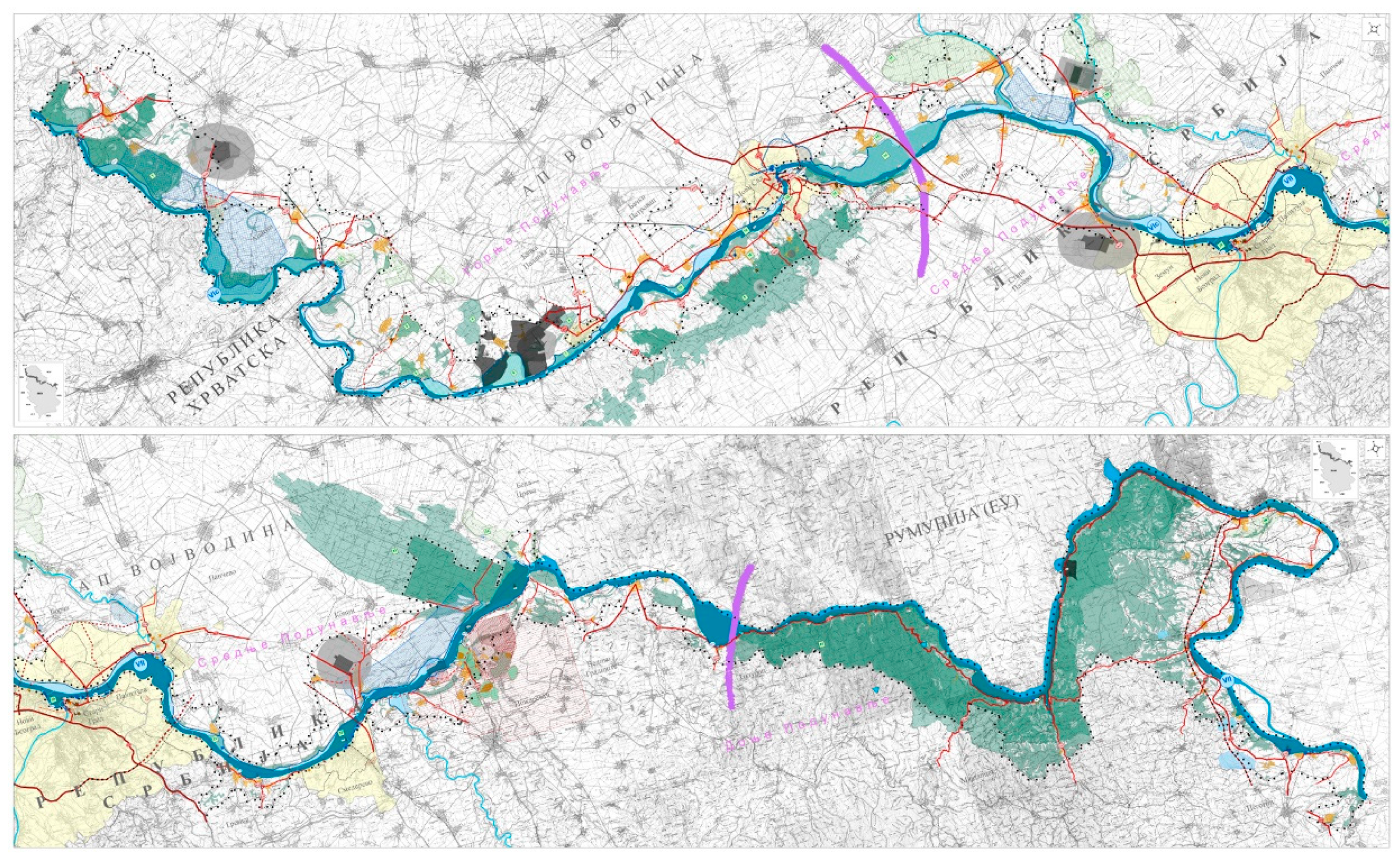
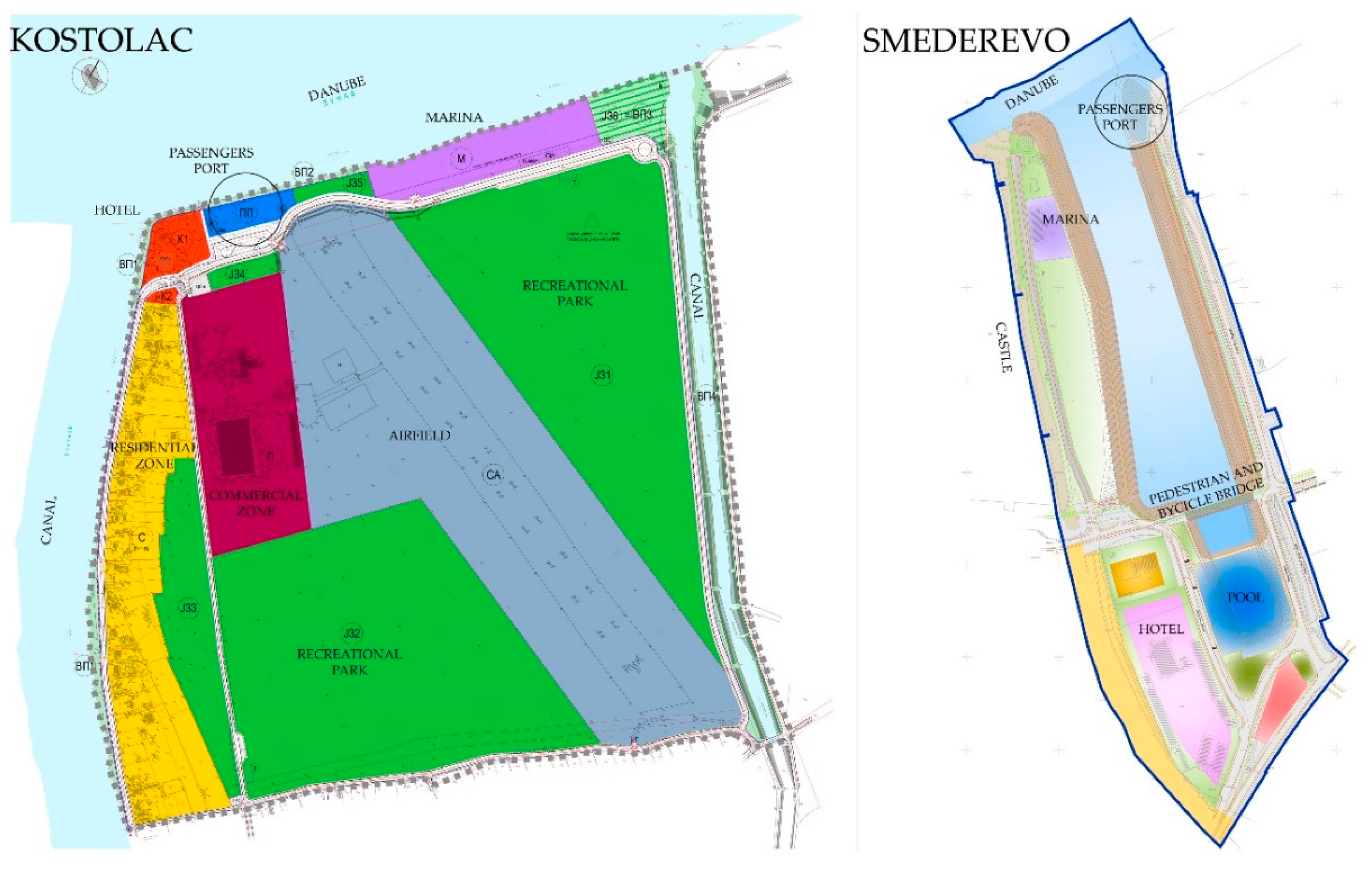
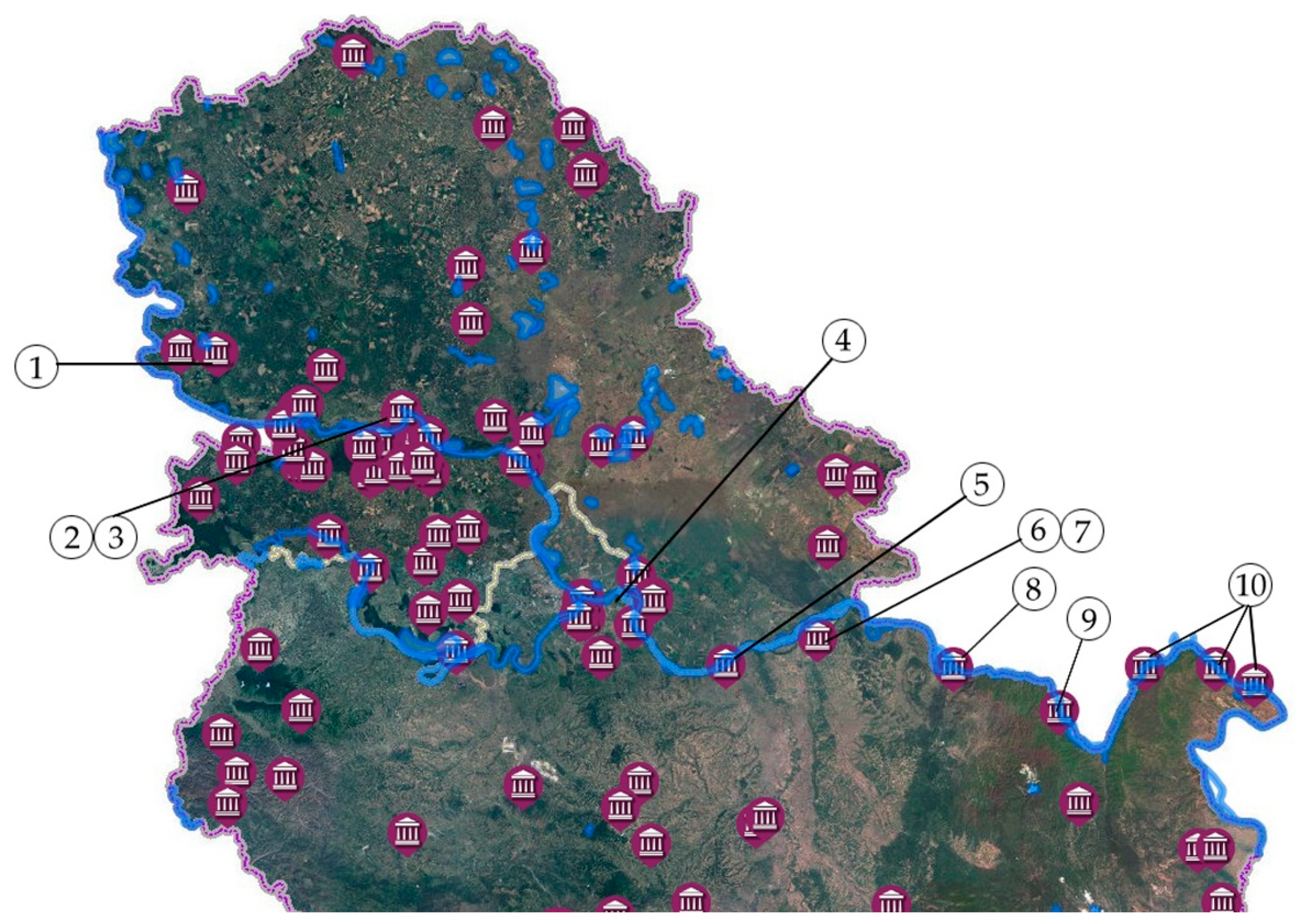
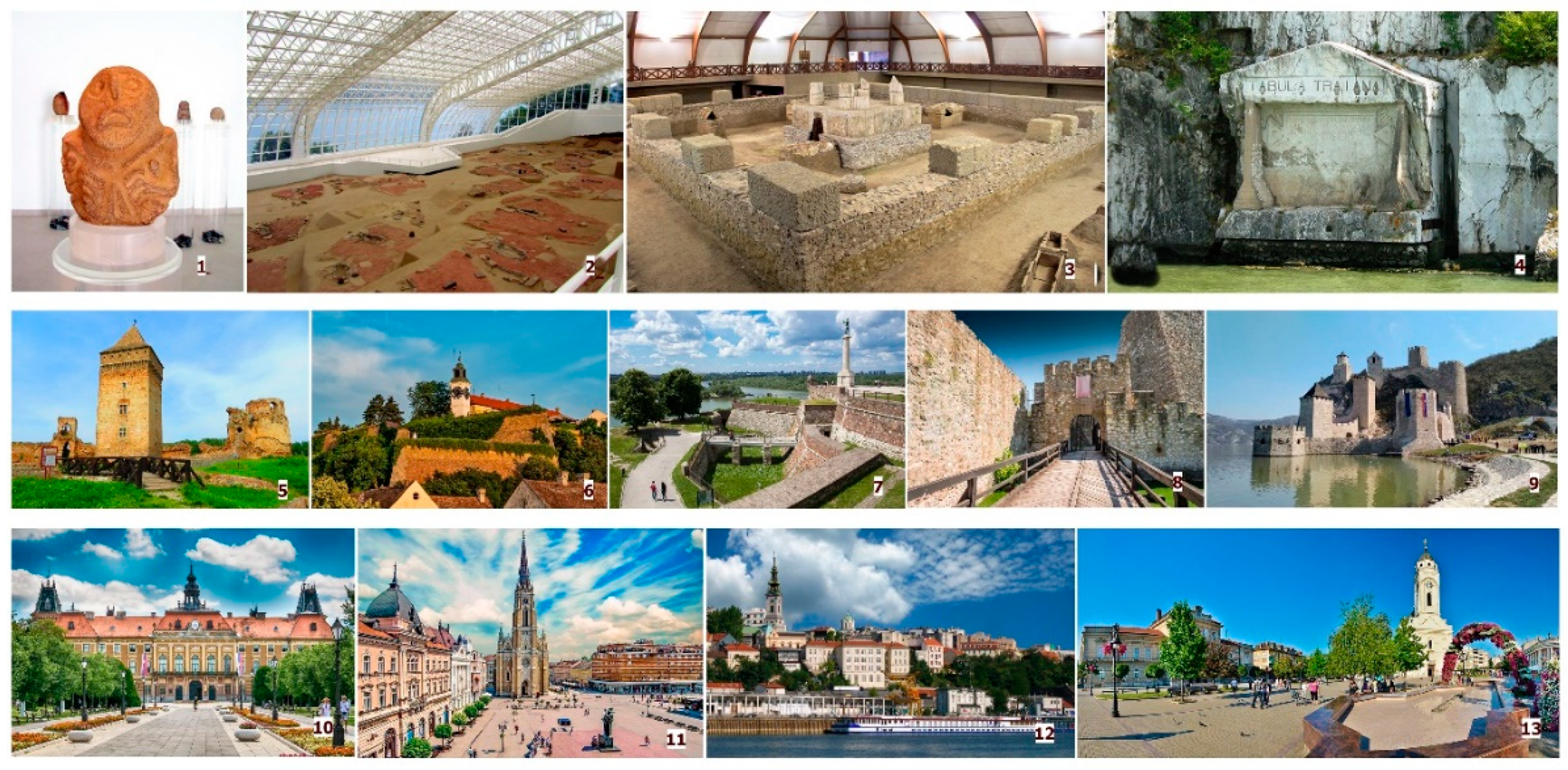
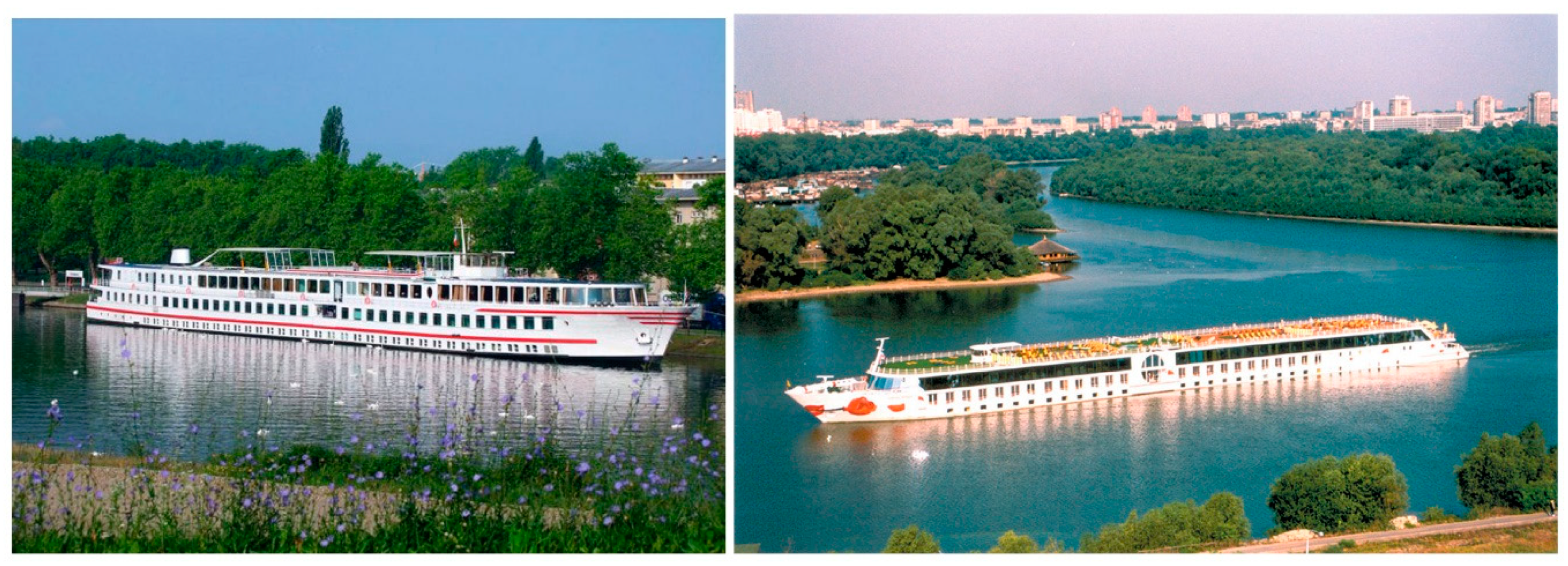
| Year | Total Number of Foreign Tourists in Serbia | Number of Cruise Passengers in Novi Sad and Belgrade | Number of Foreign Visitors in Belgrade | Number of Foreign Visitors at the EXIT Music Festival |
|---|---|---|---|---|
| 2007 | 696,045 | 445,183 | 296,461 | 50,000 |
| 2019 | 1,846,551 | 158,502 | 1,056,578 | 200,000 |
| Achieved Results in 2014 | Wien | Belgrade |
|---|---|---|
| Number of citizens | 1,741,000 | 1,639,121 |
| Total length of the Danube in the country | 357.5 km | 588 km |
| Number of cruise ship dockings | 4036 | 510 |
| Number of cruise ship passengers | 460,265 | 68,000 |
| Year | Belgrade | Novi Sad | Donji Milanovac | Golubac | Veliko Gradište |
|---|---|---|---|---|---|
| 2015 | 493 | 290 | 112 | 0 | 4 |
| 2016 | 531 | 306 | 112 | 0 | 3 |
| 2017 | 538 | 332 | 112 | 0 | 6 |
| 2018 | 587 | 347 | 143 | 44 | 21 |
| 2019 | 752 | 427 | 249 | 95 | 15 |
| Year | Belgrade | Novi Sad | Donji Milanovac | Golubac | Veliko Gradište |
|---|---|---|---|---|---|
| 2015 | 65,494 | 35,314 | 13,673 | 0 | 203 |
| 2016 | 68,541 | 36,604 | 13,425 | 0 | 305 |
| 2017 | 72,279 | 42,622 | 15,562 | 137 | 625 |
| 2018 | 81,155 | 46,490 | 20,335 | 6225 | 2873 |
| 2019 | 103,523 | 54,979 | 34,260 | 14,607 | 1275 |
| Planning Document | Relevance to the Case Study | Characteristics, Content, and Determinants |
|---|---|---|
| Spatial Plan of the Republic of Serbia | The overall document | The economy, transport, tourism, cultural co-operation, and other forms of connectivity along this development axis will support plans and projects related to corridor VII, i.e., a joint development strategy based on interstate co-operation between Danube states and the region. |
| Spatial Plan for the Special Purpose Area (SPASP) | SPASP of the International Waterway E 80 (i.e., the Danube or pan-European corridor VII) | According to this plan, existing tourist product categories are manifestation, hunting, fishing, city and health tourism (spas and wellness locations) and tourist products with exceptional potential. Nautical and ship cruising, special interests, rural tourism, events, and other categories are underregulated and affirmed. For tourism development, the international waterway has significance for international cruise ships and also for boats of all categories. |
| Detailed Urban Plan (DUP) | DUP for “Dragulj” in Kostolac | The plan includes land use for cruise ship ports with customs offices, tourist information spots, souvenir shops, cafés, car rental, parking for individual cars and tourist buses, marinas with category 3 anchors, small airports for sport airplanes, parks and recreational areas, sport polygons, camping sites with facilities, bicycle paths, and hotels and apartments. |
| DUP for “Marine Smederevo” in Smederevo | The plan considers several aspects, including marina management offices, technical maintenance and overhauling vessels (with a crane for extraction), ports/docks for large cruise ships on the Danube, commercial uses (restaurants, shopping, and services), sailing schools, indoor pools, hotels, and outdoor sports and recreation complexes. |
| Port Location and Status (Existing/Suggested or Planned/In Realization) | Nearby Heritage Sites and Cultural Products | Location Characteristics | Distance from the Port and Type of Required Transport to the Spot |
|---|---|---|---|
| Apatin (planned), with about 75 km to the next stop | City of Sombor | Ambiental value and an immovable cultural good with exceptional importance. Supports walking and visiting. | 20 km by bus |
| Bačka Palanka and Banoštor (on opposite sides, planned), with about 40 km to the next stop | Bač Fortress, monasteries in Fruška Gora National Park, and a wine route | Ambiental value and immovable cultural goods with exceptional importance. Supports walking, visiting, and tasting. | 20–30 km by bus |
| Novi Sad (existing), with about 15 km to the next stop | City of Novi Sad, Petrovaradin Fortress, monasteries in Fruška Gora National Park, and a wine route | Ambiental value and immovable cultural goods with exceptional importance. Supports sightseeing and tasting. | 0–25 km on foot or by bus |
| Sremski Karlovci (in realization), with about 80 km to the next stop | Old city, nearby to Petrovaradin and Novi Sad, monasteries in Fruška Gora National Park, and a wine route | Ambiental value and immovable cultural goods with exceptional importance. Supports sightseeing and tasting. | 0–25 km on foot or by bus |
| Belgrade, Zemun, and Vinča (existing/planned), with about 65 km to the next stop | City of Belgrade, Klamegdan Fortress, old city core (pedestrian zone, bohemian quarter, Skadarlija museums (including Museum of Nikola Tesla), and a Neolithic archeological site in Vinča | Ambiental value and immovable cultural goods with exceptional importance. Supports sightseeing, walking, gaining knowledge, and exploring. | 0–15 km on foot or by bus |
| Smederevo (in realization), with about 25 km to the next stop | City of Smederevo, a medieval fortress, and a wine route | Ambiental value and immovable cultural goods with exceptional importance. Supports sightseeing, gaining knowledge, and exploring. | 0–15 km on foot or by bus |
| Kostolac (in realization), with about 40 km to the next stop | Cities of Požarevac and Ljubičevo, archeological sites, and Viminacium | Ambiental value, immovable cultural goods with exceptional importance, and a special purpose area. Supports visiting, gaining knowledge, and exploring. | 5–15 km by bus |
| Veliko Gradište (existing), with about 20 km to the next stop | Ram Fortress | Ambiental value and an immovable cultural good with exceptional importance. | 0 km on foot |
| Golubac (existing), with about 55 km to the next stop | Medieval fortress and Đerdap National Park | Immovable cultural goods with exceptional importance. Supports gaining knowledge and exploring. | 0 km on foot |
| Donji Milanovac (existing), with about 15 km to the next stop | Emperor Trajan’s road and board from the Roman period, archeological sites, Lepenski Vir, and Đerdap National Park | Immovable cultural goods with exceptional importance. Supports walking, gaining knowledge, and exploring. | 0–15 km on foot or by bus |
| Lepenski Vir (planned), with about 80 km to the next stop | Prehistoric archeological sites | Immovable cultural goods with exceptional importance. Supports gaining knowledge and exploring. | 0 km on foot |
| Kladovo (existing), with about 55 km to the next stop | Fetislam Fortress, Trajan’s bridge, Karataš, and Diana Fortress | Sites from the Roman and Byzantine periods and immovable cultural goods with exceptional importance. | 0–15 km on foot or by bus |
| Negotin (planned) | Archeological sites, Gamzigrad-Romuliana (a UNESCO site), and the Rajačke Pimnice | Immovable cultural goods with exceptional importance. Supports gaining knowledge, exploring, and tasting. | 30–65 km by bus |
Publisher’s Note: MDPI stays neutral with regard to jurisdictional claims in published maps and institutional affiliations |
© 2020 by the authors. Licensee MDPI, Basel, Switzerland. This article is an open access article distributed under the terms and conditions of the Creative Commons Attribution (CC BY) license (http://creativecommons.org/licenses/by/4.0/).
Share and Cite
Hristić, N.D.; Stefanović, N.; Milijić, S. Danube River Cruises as a Strategy for Representing Historical Heritage and Developing Cultural Tourism in Serbia. Sustainability 2020, 12, 10297. https://doi.org/10.3390/su122410297
Hristić ND, Stefanović N, Milijić S. Danube River Cruises as a Strategy for Representing Historical Heritage and Developing Cultural Tourism in Serbia. Sustainability. 2020; 12(24):10297. https://doi.org/10.3390/su122410297
Chicago/Turabian StyleHristić, Nataša Danilović, Nebojša Stefanović, and Saša Milijić. 2020. "Danube River Cruises as a Strategy for Representing Historical Heritage and Developing Cultural Tourism in Serbia" Sustainability 12, no. 24: 10297. https://doi.org/10.3390/su122410297
APA StyleHristić, N. D., Stefanović, N., & Milijić, S. (2020). Danube River Cruises as a Strategy for Representing Historical Heritage and Developing Cultural Tourism in Serbia. Sustainability, 12(24), 10297. https://doi.org/10.3390/su122410297






